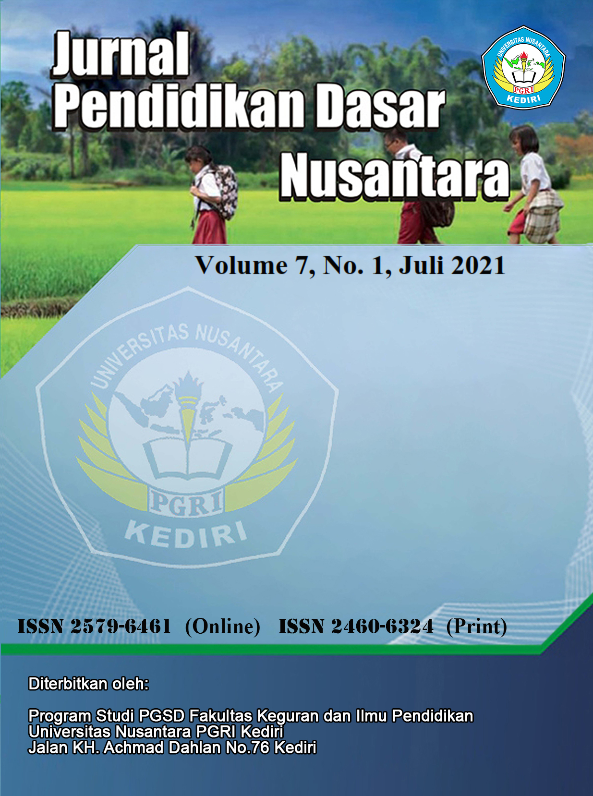Game Hago Sebagai Media Pembelajaran di Sekolah Dasar
DOI:
https://doi.org/10.29407/jpdn.v7i1.15955Keywords:
hago, online game, learning media.Abstract
Abstract: Indonesia is currently facing an industrial revolution 4.0. This affects the education era which is characterized by the use of digital technology in the learning process. The use of technology-based learning media is absolutely necessary in the learning process, Hago is one of them. The purpose of this study was to determine the effectiveness of how to improve student learning outcomes in Elementary Schools (SD) through online game learning media (Hago). This research took place at SDN Gogorante Kediri Regency with the research subjects were fourth grade students. In collecting data using 5 steps, namely identification of research variables, identification of research variables, research techniques and approaches, data collection techniques, question validation, and data analysis techniques. Based on the results of the trial, a minimum score of 50 and a maximum score of 90 was obtained with an average student score of 74.80 which was already above the KKM of 70.The conclusion from the trial results is that the use of learning media based on Hago online games has influence on student learning outcomes and is suitable for use as a learning medium.
Keywords: hago, online game, learning media.
Downloads
References
Dewi, Ghea Putrifatma. 2012. Pengembangan Game Edukasi Pengenalan Nama
Hewan Dalam Bahasa Inggris Sebagai Media Pembelajaran Siswa Sekolah Dasar Berbasis Micromedia Flash. Yogyakarta: Universitas Negeri Yogyakarta press.
Hananta, Wisnu. 2018. Rendahnya Kualitas Sarana Fisik Pendidikan di Indonesia. Salatiga: Universitas Kristen Satya Wacana Press.
Melani, Devita. 2009. Studi kasus tentang pengaruh game online pada agresivitas remaja di Surabaya. Skripsi tidak diterbitkan. Surabaya: Unair.
Nawangnugraeni, Devi Astri. 2015.Game Edukasi Android Sebagai Fasilitas Pengenalan Bilangan Untuk Anak Usia Dini. Semarang: Universitas
Negeri Semarang Press.
Nurjannah. Artikel Fasilitas Belajar Untuk Menunjang Proses Pembelajaran.
Pamungkas Bian Dwi. 2011. Pengembangan Media Pembelajaran Berbasis Game Edukasi untuk Mata Pelajaran TIK Semester Genap pada Siswa
Kelas X SMA. Malang: Universitas Negeri Malang Press.
Putra, Santya Bima. 2018. Pengembangan Media Papan Tempel padaPembelajaran Materi Daur Hidup Hewan Siswa Kelas 4 Sekolah Dasar
Tahun Ajaran 2017/2018. Skripsi Diterbitkan Terbatas. Kediri: Universitas Nusantara PGRI Press.
Saputra, H. J., Faizah, N. I. (2017). Pengembangan Bahan Ajar Untuk Menumbuhkan Nilai Karakter Peduli Lingkungan Pada Siswa Kelas Iv Sekolah Dasar. Profesi Pendidikan Dasar, Vol. 4, No. 1.
Suciadi, Eka Rizki. 2018. Pengaruh Media Torso terhadap Kemampuan Menjelaskan Alat Gerak dan Fungsinya pada Hewan dan Manusia serta
Cara Memelihara Kesehatan Alat Gerak Manusia Subtema Manusia dan Lingkungan Tema Organ Gerak Hewan dan Manusia pada Siswa Kelas V
SDN Ngadisuko 3 Kabupaten Trenggalek Tahun Ajaran 2018/2019. Skripsi Diterbitkan Terbatas. Kediri: Universitas Nusantara PGRI Press.
Sulistyorini, Tutut. 2018. Mendeteksi Kemampuan Matematika Siswa SMP Kelas
VII Berdasarkan Pola Sidik Jari. Skripsi Diterbitkan Terbatas. Kediri: Universitas Nusantara PGRI Press.
Kusumaningrum,Triana. 2016. Pengembangan Game Edukasi Berbasis Android
Untuk Belajar Kosakata Bahasa Prancis di Sma Negeri 2 Klaten. Skripsi Diterbitkan Terbatas. Yogyakarta: Universitas Negeri Yogyakarta Press.
Tafonao, T. (2018). Peranan Media Pembelajaran Dalam Meningkatkan Minat Belajar Mahasiswa. Jurnal Komunikasi Pendidikan, Vol.2 No.2.
Undang-Undang Republik Indonesia Nomor 20 tahun 2003 tentang SistemPendidikan Nasional. SIPUU SETKAB di http://sipuu.setkab.go.id/PUUdoc/7308/UU0202003.htm. Diakses online pada tanggal 20 Januari 2021.
Downloads
Published
Issue
Section
License
Authors who publish with this journal agree to the following terms:
- Copyright on any article is retained by the author(s).
- The author grants the journal, the right of first publication with the work simultaneously licensed under a Creative Commons Attribution License that allows others to share the work with an acknowledgment of the work’s authorship and initial publication in this journal.
- Authors are able to enter into separate, additional contractual arrangements for the non-exclusive distribution of the journal’s published version of the work (e.g., post it to an institutional repository or publish it in a book), with an acknowledgment of its initial publication in this journal.
- Authors are permitted and encouraged to post their work online (e.g., in institutional repositories or on their website) prior to and during the submission process, as it can lead to productive exchanges, as well as earlier and greater citation of published work.
- The article and any associated published material is distributed under the Creative Commons Attribution-ShareAlike 4.0 International License
































